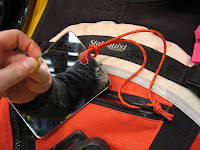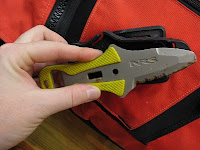 When I travel, I go as light as possible. Every item I take is carefully chosen, and everything fits into my carry-on bag and my "personal item"
When I travel, I go as light as possible. Every item I take is carefully chosen, and everything fits into my carry-on bag and my "personal item"Usually, my carry-on bag is an Osprey Aura 50 and my 'personal item' is either a day-pack or my laptop bag.
Your goal should be to get everything into the two bags you bring aboard the plane.
Yes it's possible. Anyone can pack this effectively and efficiently. I'll help you know what to look for in clothing to enable you to pack light and still be prepared for whatever you encounter on your adventure.
Basic Guidelines
The clothes you bring on your journey should be:
- Wrinkle resistant
- Stain resistant
- Fast drying
- Multi-functional
- Have secure pockets
- Be comfortable
- Reflect your personal style
When we travel, we don't know what we'll run into around the corner. Laundry facilities aren't always accessible. It's important to have the option to wash a pair of pants in a sink in your hotel room, letting them hang to dry overnight. You might spend a morning hiking and the afternoon shopping. You'll have more time to do both if you don't have to stop by your hotel room to change clothes. If you were to say, go to an outdoor retailer, and say, "I need clothes that dry quickly, won't wrinkle and resist stains," you'll might be directed to a long sleeve button up shirt and a pair of zip off pants
This outfit would be functional, but I think it is also equally important to feel stylish and comfortable in your clothes. When I first started traveling, I thought I was forever doomed to wear quick dry cargo pants and button ups. This is most definitely not my style. It also identifies just about anyone wearing it as a tourist. Consider where you're headed. Going to Paris, Monaco or Italy? You'll want to feel stylish and chic. Headed to the Caribbean? Breezy clothes fit the mood and the environment. Bright, vibrant colors are fun in Brazil, but may not blend well some parts of the Middle East.
When choosing styles, consider the following things;
- Your destination: will you need to cover your skin or can you wear tank tops and shorts?
- The styles you already wear on a daily basis
- What kinds of clothes you are comfortable in?
- Clothes that make you feel good
- The activities you want to participate in
Its hard to believe, but every single item shown above serves more than one purpose and is made from quick drying fabric. These are not only my favorite travel clothes, but clothes I enjoy wearing when I'm not traveling.
Here's the list of the above items:
-Bliss Knickers by prAna- exploring town, climbing, hiking, swimming, biking
-Bliss Pants by prAna- exploring town, going to dinner, hiking, climbing, biking
-Yoga pants from prAna-long flights, climbing, hiking, dinner, exploring
-a functional tank top from prAna- climbing, yoga, dinner, exploring
-Patagonia R1 1/2 zip jacket- long flights, chilly nights, hiking
-ExOfficio hoody- sun protection, skin coverage for conservative areas
-Columbia Marrakesh Maven dress- out to dinner, dancing, exploring town
-tie front shrug to wear with tank tops and sleeveless dresses to cover skin
When you shop, look for brands that make travel oriented clothes. Most brands that make clothing for the great outdoors make clothing for travel. prAna, Columbia, Patagonia, ExOfficio, Mountain Hardware, The North Face, Royal Robins, and Isis all make high quality travel clothes in a wide range of styles. For fast dry times, look for high polyester or nylon content. Stay away from high percentages of cotton and spandex. A little spandex (2 to 8%) is a good thing because it makes clothes more comfortable on long rides and diverse activities. Merino wool is a great option for warm and cool arid climates. It's soft, dries quickly and can be worn over and over again without starting to stink. Think about what is already in your closet that you enjoy. Try to find pieces that have a similar cut or look. You might already have items in your closet that will work well. Read the labels! Often you'll be surprised you already own clothes well suited for travel.
Try to choose pieces that you can layer or pieces that are multi-functional. Every item you bring should serve more than one purpose. A long sleeve tunic top layers well over a tank top for chilly nights, provides sun protection or covers skin when visiting a conservative area. I always bring pair of black yoga pants that dry quickly. They are comfortable on long plane rides and perfect for rock climbing. Long tunics or dresses can be belted and worn with heels or sandals for dinner and dancing, or layered over jeans or leggings for cooler weather or more causal evenings.
Sometimes I bring things that break those rules...
I've also learned to bring a few things that don't fit those standards. While I was in Dubai, I really needed a pair of heels, or at least a pair of dressy flats. We went out to dinner and dancing a few times and I really didn't fit in wearing water sandals or hiking shoes. A dark pair of jeans that fit well and look good can be dressed up or down, worn with hiking shoes or heels. One might think, "How would I have room in my bag for a pair of bulky, heavy jeans or a bulky pair of heels?" Packing efficiently left plenty of room for jeans. Because I know I'll get a fair amount of use out of a pair of dressy shoes, I can justify the space I'm taking up with them.
I also took a bikini, even though I was going to a very conservative country. I actually used it quite a bit! Usually we swam in secluded coves, which we had entirely to ourselves. Once in a while we would swim on a resort beach, where bikinis were a common sight. Flip flops are also a staple I bring from home or buy once I arrive. At our house in Oman, the front yard was gravel. I would have to put on shoes that laced every time I wanted to run out to the car. Flip flops make air port security a breeze, public showers safer, and running down the hall of the hotel for more ice more convenient.
Wondering about that pretty bag in the photo above? Check out my post next week on bags for traveling light.






























